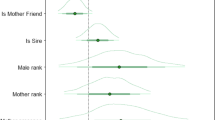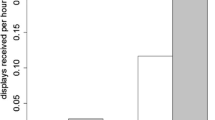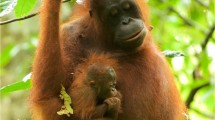Abstract
Two alternative theories have been proposed to explain why some male primates carry infants during agonistic encounters with other males. The first (agonistic buffering) suggests that males carry the infants of higher ranking opponents in order to defuse the latter's aggression; the second (progeny protection) suggests that males carry their own infants as a warning to opponents that they will be prepared to fight vigorously in order to protect their offspring from injury. Evidence is presented to show that both occur in gelada baboons under different circumstances and that, in addition, infant-use may in at least some cases involve indirect solicitation of support from a third party (normally the infant's mother).
Similar content being viewed by others
References
Busse, C. &W. J. Hamilton, 1981. Infant carrying by male chacma baboons.Science, 212: 1281–1283.
Crook, J. H., 1966. Gelada baboon herd structure and movement: a comparative report.Symp. Zool. Soc., London, 18: 237–258.
Deag, J. M. &J. H. Crook, 1971. Social behaviour and “agonistic buffering” in the wild Barbary macaque.Folia Primatol., 15: 183–200.
Dunbar, R. I. M., 1983. Structure of gelada baboon reproductive units. III. The male's relationship with his females.Anim. Behav., 31: 565–575.
————, 1984.Reproductive Decisions: An Economic Analysis of Gelada Baboon Social Strategies. Princeton Univ. Press, Princeton, New Jersey.
———— &P. Dunbar, 1975.Social Dynamics of Gelada Baboons. S. Karger, Basel.
Hrdy, S. B., 1979. Infanticide among mammals: a review classification and examination of the implications for the reproductive strategies of females.Ethol. Sociobiol., 1: 13–40.
Itani, J., 1959. Paternal care in the wild Japanese monkey,Macaca fuscata fuscata.Primates, 2: 61–93.
Kawai, M. (ed.), 1979.Ecological and Sociological Studies of Gelada Baboons. Kodansha, Tokyo & S. Karger, Basel.
Kummer, H., 1967. Tripartite relations in hamadryas baboons. In:Social Communication Among Primates,S. A. Altmann (ed.), Chicago Univ. Press, Chicago, pp. 63–72.
Mori, U., 1979. Individual relationships within a unit. In:Ecological and Sociological Studies of Gelada Baboons,M. Kawai (ed.), Kodansha, Tokyo & S. Karger, Basel, pp. 93–124.
Packer, C., 1980. Male care and exploitation of infants inPapio anubis.Anim. Behav., 28: 512–520.
Ransom, T. W. &B. S. Ransom, 1971. Adult-male-infant relations among baboons (Papio anubis).Folia Primatol., 16: 179–195.
Struhsaker, T. T., 1977. Infanticide and social organization in the redtail monkey (Cercopithecus ascanius schmidti) in the Kibale Forest, Uganda.Z. Tierpsychol., 45: 75–84.
Author information
Authors and Affiliations
About this article
Cite this article
Dunbar, R.I.M. Infant-use by male gelada in agonistic contexts: Agonistic buffering, progeny protection or soliciting support?. Primates 25, 28–35 (1984). https://doi.org/10.1007/BF02382293
Received:
Accepted:
Issue Date:
DOI: https://doi.org/10.1007/BF02382293




